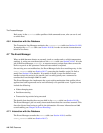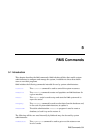The Machine Manager
4.1.1 Startup
RMS is started as each node executes the initialization script /sbin/init.d/rms with
the start argument on startup. This starts the rmsmhd daemon which, in turn, starts
the other daemons on that node.
The daemons can also be started, stopped and reloaded individually by rcontrol once
RMS is running. See Page 5-20 for details.
4.1.2 Log Files
Output from the management daemons is logged to the directory /var/rms/adm/log.
The log files are called daemon.log, where daemon gives the name of the RMS daemon,
such as swmgr. The Partition Managers are distinguished by suffixing pmanager with a
hyphen and then the name of the partition. For example, the Partition Manager for the
partition par1 is known is pmanager-par1.
Errors are logged to /var/rms/adm/log/error.log.
Output from rmsmhd and rmsd is logged to /tmp/rms.log on each node.
4.1.3 Daemon Status
The servers table contains information on the status of each daemon: the time it was
started, its process ID and the name of its host node (see Section 10.2.19 for details of
the table structure).
Note that the status field in the servers table is set to error if an error occurs when
starting an RMS daemon. The corresponding entry in the events table describes what
went wrong (see Chapter 8 (Event Handling) for details).
The command rinfo can be used to get reports on the status of each daemon. See
Page 5-32 for details.
4.2 The Database Manager
The Database Manager, msqld, manages the RMS database, providing an SQL interface
for its clients. Client applications may use C, C++, Java or UNIX scripts to generate SQL
queries for msqld.
The database holds all state information for RMS. This information is initially created
by the RMS client application rmsbuild (see Page 5-35). The information is updated by
the other RMS daemons as RMS operates. The information can be backed up, restored
and generally maintained using the database administration program, rmstbladm (see
Page 5-44).
4-2 RMS Daemons


















